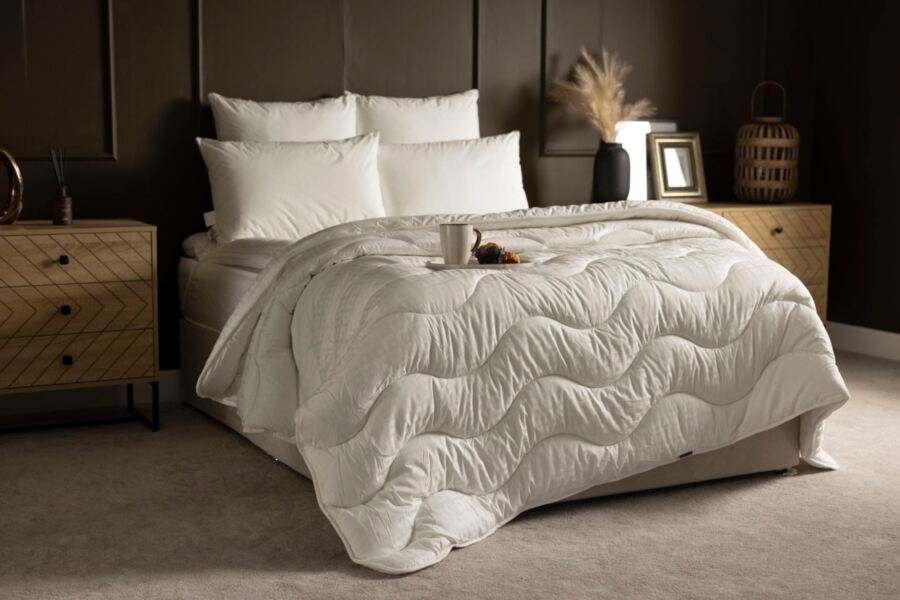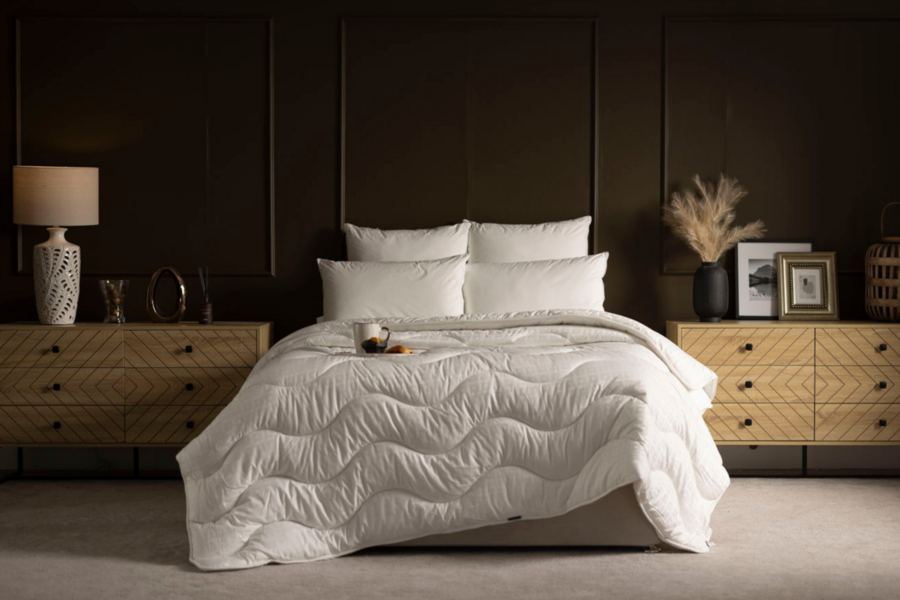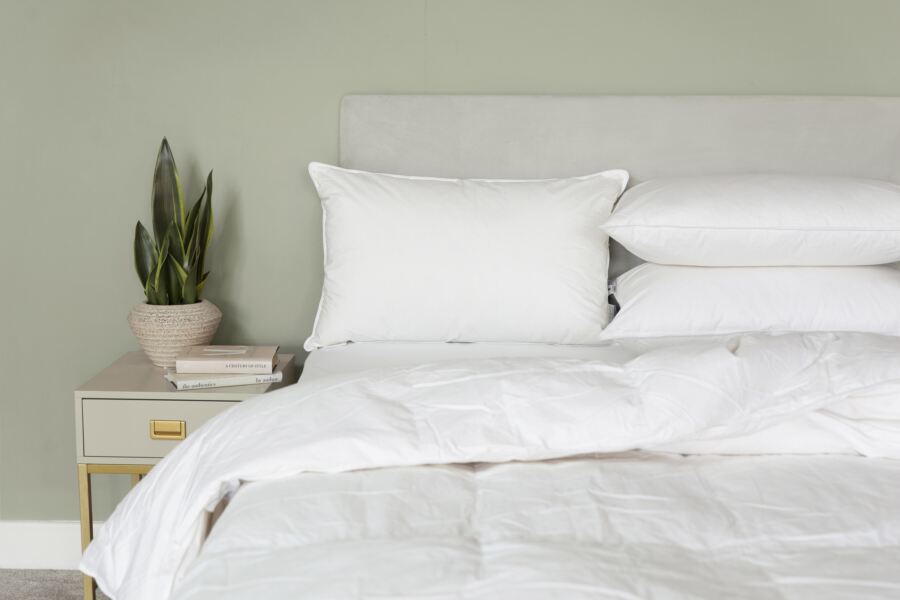Table of Contents
- Understanding the Difference Between Summer and Winter Duvets
- How to Know When it's Time to Switch
- Why You Should Have Separate Winter and Summer Duvets
- FAQs
- Final Thoughts
As the weather shifts from warm summer nights to chilly winter evenings, your bedding needs to keep up.
Switching to a warmer duvet at the right time keeps you snug and helps you wake up refreshed. It’s all about finding the balance between staying cosy and avoiding overheating, no matter the season.
In this article, we explain the differences between duvet tog ratings and what you need to consider for different seasons, so you can make the switch at just the right time.
Understanding the Difference Between Summer and Winter Duvets
The easiest way to know when to switch your duvet is by looking at the tog rating. This rating measures how well a duvet insulates and traps heat. The higher the tog, the warmer the duvet will feel.
While personal preference and bedroom temperature play a role, the general rule of thumb is to use a lower tog in summer and a higher tog in winter.
Here's a brief breakdown of the differences between seasonal duvets.

Summer duvets
Summer duvets typically range between 2.5 and 4.5 tog. They’re designed to feel lightweight and breathable, making them ideal for hot sleepers or warm nights.
A summer duvet helps you stay comfortable without overheating, especially if your room tends to hold heat during the night.
Winter duvets
When the average temperatures begin to drop, you'll want a heavier duvet to welcome the cosy season. Winter duvets usually fall between 10.5 and 13.5 tog, and are designed to provide extra insulation.
A winter duvet eliminates the need for multiple blankets, giving you all the warmth you need in a single layer. If you live in a particularly chilly area, going toward the higher end of the tog scale is a smart choice.
Other duvets
Not every night is peak summer or deep winter, which is where spring and autumn duvets come in. These mid-weight options (around 7–10 tog) are great for transitional seasons when the weather can be unpredictable.
For even more convenience, some people opt for an all-season duvet. It combines a light summer duvet and a warmer winter duvet that can be used separately or snapped together depending on the time of year.
How to Know When it's Time to Switch
So, how do you know when it’s time to put away the light summer bedding and reach for a thick duvet and cosy blankets?
While there isn't an exact date, sleep experts generally recommend keeping your bedroom temperature between 15–19°C for optimal rest. If the nights are dipping below this range and you find yourself waking up chilly, it’s a good indicator that it’s time to switch to a warmer duvet.
Temperature isn’t the only thing to consider, though. Your home, lifestyle, and personal comfort all play a part. Here are some factors to think about:
The size of your room
Smaller bedrooms tend to warm up faster and hold heat better, while larger rooms can feel cooler at night. If you’re in a spacious or drafty room, you might need to move to your winter duvet earlier than someone in a cosy, compact space.
Climate
Where you live plays a huge role in your bedding requirements. In milder regions, you may only need a mid-weight duvet year-round, while colder climates often call for a dedicated winter duvet as soon as autumn sets in.
Duvet material
The filling of your duvet can also influence when it feels right to switch.
Natural fillings like down and feathers are excellent at trapping warmth, so they might keep you cosy enough well into autumn before needing to upgrade to a heavier duvet. Synthetic fillings don’t insulate as effectively, so you may need to switch sooner once the temperatures drop.

Insulation
The way your home is built and insulated also affects your comfort at night. A well-insulated property will stay warmer for longer, while older or poorly insulated homes may require a switch to heavier bedding well before the "official" winter months.
Whether or not you sleep alone
Sharing a bed naturally means more body heat, which keeps you warmer through the night. Couples often stick with lighter duvets for longer, whereas solo sleepers may need to upgrade to a higher tog as soon as the temperature drops.
Personal preferences
Everyone’s comfort level is different. Some people naturally run hot and may prefer a lighter duvet even in winter, while others feel the chill easily and like to switch earlier. Paying attention to how you feel in the mornings will help you figure out the best time to switch.
Why You Should Have Separate Winter and Summer Duvets
You might wonder if it’s worth having two duvets instead of using one all year. The answer is yes, and here’s why it makes sense:
-
Better sleep quality: Using the right tog for the season keeps your body at a comfortable temperature, helping you fall asleep faster and stay asleep longer. Sleep quality affects your mood, energy levels, and overall well-being, so it's well worth investing in.
-
Energy savings: Instead of cranking up the heating in winter or blasting a fan in summer, a suitable duvet helps regulate your comfort naturally. This could end up saving you hundreds in electricity costs over time.
-
Longer duvet lifespan: Rotating between two duvets reduces wear and tear, meaning each one lasts longer and maintains its quality. You could keep each duvet for many years, especially if you wash and store them properly.
-
More flexibility: Having two duvets lets you adapt to changing weather, like a sudden cold snap in autumn. You’ll always have the right bedding to stay comfortable.
-
Hygiene and freshness: Switching duvets gives you the chance to air out and wash the one you’re not using, keeping your bedding cleaner overall. This is especially helpful for those who struggle with allergies.
Investing in both a summer and winter duvet doesn’t just make sense for comfort purposes. It’s also practical, cost-effective, and better for your sleep in the long run.
FAQs
Is a 10.5 tog duvet too cold for winter?
A 10.5 tog duvet could be suitable for winter if you live in a well-insulated home or an area with a warmer climate. However, this tog rating may not be high enough if you live in a colder country, such as the UK.
Is a 13.5 tog duvet too warm for summer?
Generally, 13.5 tog duvets are considered too warm to be used as part of your summer bedding, as this tog rating is designed for colder weather. In summer, you'd be better off with a lighter duvet (around 4.5 tog).
Is it necessary to change my duvet seasonally?
Of course, you don't have to, but there are plenty of benefits that come with switching your bedding seasonally. Most importantly, the right duvet offers better temperature regulation, so you can look forward to improved sleep comfort.
What other bedding items should I change for winter?
When winter rolls around, you may want to add extra blankets to your bed. You may also want to opt for warmer sheets and pillowcases, made from cosy materials like flannel, jersey cotton, or brushed cotton. A mattress topper is also a great way to add an extra layer of warmth.
What is the best tog for year-round use?
If you're looking for a duvet that can be used all year round, your best bet is to go with a 10.5 tog. In winter, you could add extra blankets for more warmth, and in summer, you could use breathable sheets and pillowcases to stay cooler.
Final Thoughts
Your duvet plays an incredibly important role in how well you sleep and how comfortable you feel at night. Choosing the right tog at the right time of year can make the difference between tossing and turning or enjoying a deep, restful night’s sleep.
While the exact moment to switch from summer to winter bedding depends on factors like climate and insulation, having both options available prepares you for any unexpected temperature changes.
By paying attention to how your body feels at night and keeping a summer and winter duvet on hand, you’ll sleep better and keep your bedding in good shape for longer.














